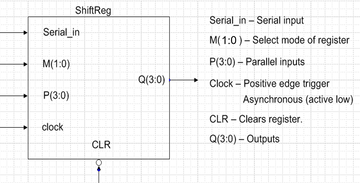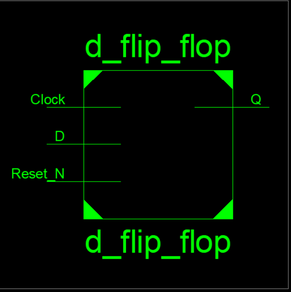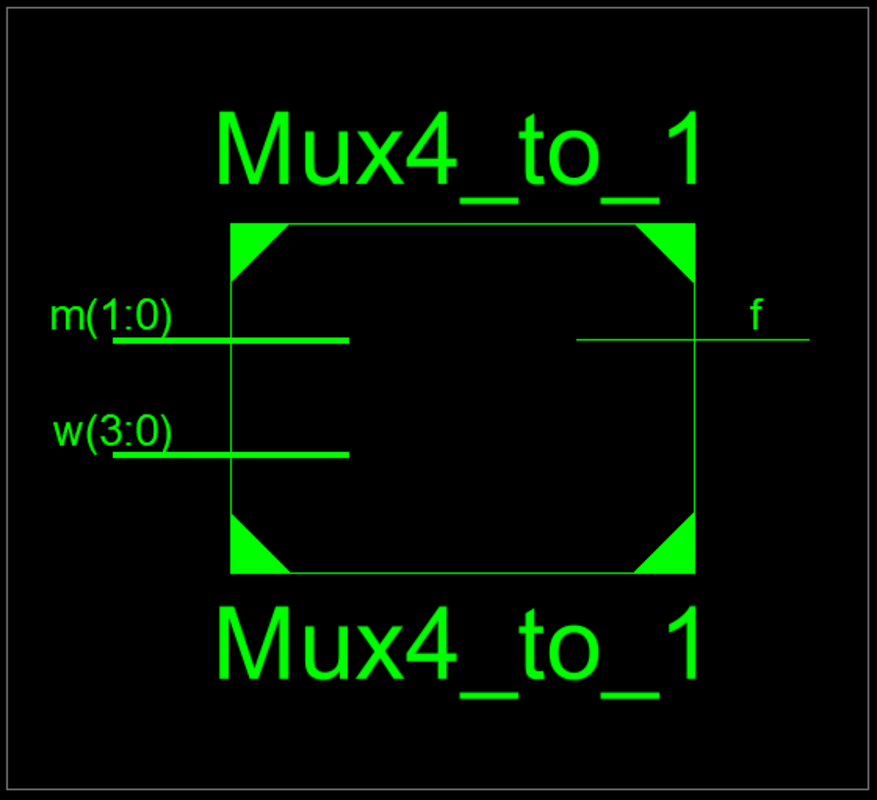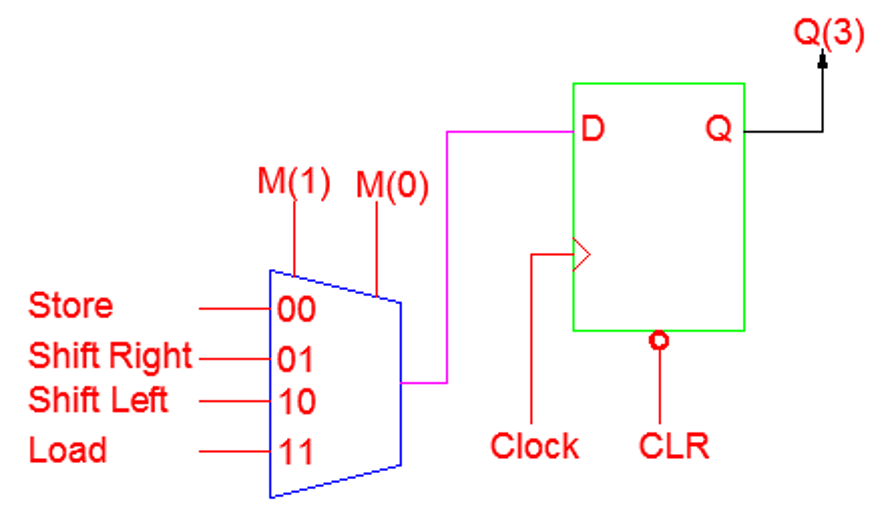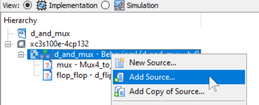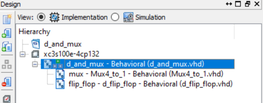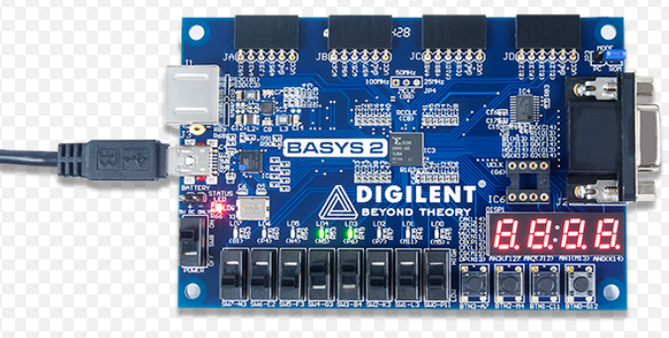VHDL - Programming the Field Programmable Gate Array (FPGA)Universal Shift Register
For this tutorial, we will be using a pre-designed D flip flop and 4 to 1 mux VHDL design codes. Then we will instantiate the components as requires to achieve the desired design out puts.
\(\color{red}{Note:}\) make sure you save the D flip flop and 4 to 1 mux in the same directory as the Universal Shift Register.
First, write a VHDL behavioral code for the D flip flop and multiplexer module using behavioral abstract techniques.
\(\color{red}{Note:}\) don't forget to write VHDL code the D flip flop and 4 to 1 mux and save them in the same directory as the D-FF and Mux combined Module and Universal Shift Register (VHDL code shown below). 1. D-Flip-Flop with Asynchronous Reset
Design the model of the D-flip-flop as shown in the code below. In order to model the asynchronous behavior of the "reset" signal, add reset and clock in the sensitivity list of the "process" block. The clock and reset signals are now used to trigger the process. The if/elsif statement checks if the reset input has been asserted. If it is asserted, then it makes the appropriate assignments to the output, Q. If the reset has not been asserted, the elsif clause checks if a rising edge of the clock has occurred. If it is, the outputs are updated accordingly (Q <= D, Qn <= ~ D). The VHDL code below shows the behavioral model for a rising edge triggered D-flip-flop with an asynchronous reset.
2. Multiplexer (4 to 1 mux)
A multiplexer is a circuit that passes one of its multiple inputs to an output based on a select input m[0:1]. This can be The VHDL code below shows the process of designing a 4-to-1 multiplexer using behavioral modeling technique.
3. D-Flip-Flop and Mux
Then, write a VHDL structural code for the D flip flop and multiplexer module by using the previously designed D flip flop & multiplexer. 4. D-FF and Mux VHDL code
5. Universal Shift Register VHDL codeNext, write a VHDL structural code for the Universal Shift Register by instantiating the combined D flip flops and Multiplexers modules (d_and_mux) using the component port map statements.
library IEEE;
use IEEE.STD_LOGIC_1164.ALL;
entity uni_shift_reg is
Port ( input : in STD_LOGIC;
load : in STD_LOGIC_VECTOR (3 downto 0);
outp : out STD_LOGIC_VECTOR (3 downto 0);
clk_1 : in STD_LOGIC;
sel : in STD_LOGIC_VECTOR (1 downto 0);
clr_1 : in STD_LOGIC);
end uni_shift_reg;
architecture Behavioral of uni_shift_reg is
component d_and_mux
Port ( in_put : in STD_LOGIC_VECTOR (3 downto 0);
Sel : in STD_LOGIC_VECTOR (1 downto 0);
clk : in STD_LOGIC;
clearN : in STD_LOGIC;
Outp : out STD_LOGIC);
end component;
signal sh_left: STD_LOGIC_VECTOR (2 downto 0);
signal sh_right: STD_LOGIC_VECTOR (3 downto 0);
signal store: STD_LOGIC_VECTOR (3 downto 0);
begin
Stage3: d_and_mux
PORT MAP (in_put(0) => store(3),
in_put(1) => input,
in_put(2) => sh_left(2),
in_put(3) => load(3),
clk => clk_1,
Sel => sel,
clearN => clr_1,
OutP => sh_right(3));
Stage2: d_and_mux
PORT MAP (in_put(0) => store(2),
in_put(1) => sh_right(3),
in_put(2) => sh_left(1),
in_put(3) => load(2),
clk => clk_1,
Sel => sel,
clearN => clr_1,
OutP => sh_right(2));
Stage1: d_and_mux
PORT MAP (in_put(0) => store(1),
in_put(1) => sh_right(2),
in_put(2) => sh_left(0),
in_put(3) => load(1),
clk => clk_1,
Sel => sel,
clearN => clr_1,
OutP => sh_right(1));
Stage0: d_and_mux
PORT MAP (in_put(0) => store(0),
in_put(1) => sh_right(1),
in_put(2) => input,
in_put(3) => load(0),
clk => clk_1,
Sel => sel,
clearN => clr_1,
OutP => sh_right(0));
outp(3) <= sh_right(3);
store(3) <= sh_right(3);
outp(2) <= sh_right(2);
store(2) <= sh_right(2);
sh_left(2) <= sh_right(2);
outp(1) <= sh_right(1);
store(1) <= sh_right(1);
sh_left(1) <= sh_right(1);
outp(0) <= sh_right(0);
store(0) <= sh_right(0);
sh_left(0) <= sh_right(0);
end Behavioral;
6. Test Bench
The functionality of the VHDL designs is verified through a simulation using a test bench. A test bench is a VHDL system that instantiates the system to be tested (the system being tested is often called a Device Under Test (DUT) or Unit Under Test (UUT)) and then simulates the input parameters and displays the outputs as a waveform. LIBRARY ieee;
USE ieee.std_logic_1164.ALL;
ENTITY Uni_shift_reg_TB IS
END Uni_shift_reg_TB;
ARCHITECTURE behavior OF Uni_shift_reg_TB IS
-- Component Declaration for the Unit Under Test (UUT)
COMPONENT uni_shift_reg
PORT(
input : IN std_logic;
load : IN std_logic_vector(3 downto 0);
outp : OUT std_logic_vector(3 downto 0);
clk_1 : IN std_logic;
sel : IN std_logic_vector(1 downto 0);
clr_1 : IN std_logic
);
END COMPONENT;
--Inputs
signal input : std_logic := '0';
signal load : std_logic_vector(3 downto 0) := (others => '0');
signal clk_1 : std_logic := '0';
signal sel : std_logic_vector(1 downto 0) := (others => '0');
signal clr_1 : std_logic := '0';
--Outputs
signal outp : std_logic_vector(3 downto 0);
-- Clock period definitions
constant clk_1_period : time := 10 ns;
BEGIN
-- Instantiate the Unit Under Test (UUT)
uut: uni_shift_reg PORT MAP (
input => input,
load => load,
outp => outp,
clk_1 => clk_1,
sel => sel,
clr_1 => clr_1
);
-- Clock process definitions
clk_1_process :process
begin
clk_1 <= '0';
wait for clk_1_period/2;
clk_1 <= '1';
wait for clk_1_period/2;
end process;
-- Stimulus process
stim_proc: process
begin
-- test CLR
clr_1<='0';
wait for 30ns;
-- test parallel loading
clr_1<='1';
sel<="11";
load<="0110";
wait for 40ns;
-- test shift right
sel<="01";
input<='1';
wait for 80ns; -- shift 4 bits
-- test shift left
sel<="10";
input<='0';
wait for 80ns; -- shift 4 bits
wait;
end process;
END;
Next, simulate the testbench code and obtain a wave form similar to the one shown below. Don't forget to adjust the simulation run time to at least 200ns to allow the testbench code goes through all the possible combinations of the inputs.
PORT mapping for Basys FPGA
User Constraint File (UCF) for - Basys 2 FPGA Board
# PlanAhead Generated physical constraints Finally, generate a programming file (.bit), Connect the FPGA board to the computer and program the FPGA board using the ADEPT software.
For more information visit: Basys 2 Reference Manual |
